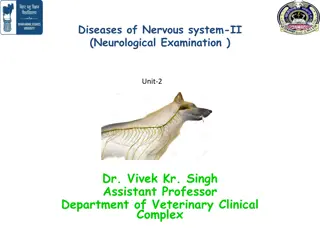MANGE IN DOGS AND CATS
Mange, caused by microscopic mites, can lead to severe skin irritation in pets. Learn about sarcoptic, demodectic, and otodectic mange, their symptoms, and treatment options to help your furry friends.
Download Presentation

Please find below an Image/Link to download the presentation.
The content on the website is provided AS IS for your information and personal use only. It may not be sold, licensed, or shared on other websites without obtaining consent from the author.If you encounter any issues during the download, it is possible that the publisher has removed the file from their server.
You are allowed to download the files provided on this website for personal or commercial use, subject to the condition that they are used lawfully. All files are the property of their respective owners.
The content on the website is provided AS IS for your information and personal use only. It may not be sold, licensed, or shared on other websites without obtaining consent from the author.
E N D
Presentation Transcript
MANGE IN DOGS AND CATS Prof: KAMAL M. ALSAAD
Mange is caused by tiny external parasites called mites which can lead to severe irritation of the skin which can significantly impact the pets quality of life. Types of mange There are three types of mites responsible for mange in pets Sarcoptes mites cause sarcoptic mange Demodex mites cause demodectic mange Ear mites (Otodectes cynotis) cause otodectic mange
Sarcoptic mange Sarcoptic mange (also known as scabie) is a highly contagious skin condition caused by microscopic Sarcoptes mites. Sarcoptic mange is an extremely itchy skin disease. The pet variety of the mite can also infest humans and cause temporary dermatitis with intensely itchy skin lesions that can last for several weeks.
Demodectic mange Demodectic mange is caused by microscopic Demodex mites that live in the pets hair follicles. Demodex mites are a normal inhabitant of a dog s skin, however, they can cause skin disease if the immune system cannot control the mite population
Otodectic mange Otodectic mange is a common condition, caused by ear mites (Otodectes cynotis). Ear mites can cause intense ear irritation and discomfort. These tiny parasites feed on wax and oils in ear canals. They can result in head shaking or scratching, rubbing of the ears and secondary ear infections.
Symptoms of Mange Clinical signs of mange include: Severe itching Biting the skin (less common in demodectic mange) Alopecia (hair loss) with Redness of the skin Excoriations (self-inflicted superficial or deep wounds) Raised bumps (papules) most commonly on the chest. Thick crusted skin typically found on the margins of the ears, the ankles (hocks), armpits, and elbows .and scabs Often, secondary skin infections occur because of the skin lesions. Weight loss, depression, decreased appetite, and lethargy can be caused by the severe itching and uncomfortable skin issues. Enlarged lymph nodes may be found too. A subtype of scabies called Norwegian scabies is characterized by severe skin crusting and is thought to be worsened by a compromised immune system
Treatment 1- Amitraz (Triazapentadiene ) Amitraz is a topical treatment primarily used to treat pet ectoparasites , Amitraz for demodicosis is applied topically as a bath or dip pouring or spray. The recommended concentration varies from 0.025% to 0.06% once weekly to every two weeks. Clinical signs of toxicosis include hypotension, hypothermia, bradycardia, convulsions, mydriasis, CNS and respiratory depression, lethargy, ataxia, hypersalivation, anorexia, vomiting, hyperglycemia, and gastrointestinal disorders in animals. Atipamezole or yohimbine is a specific antidote with symptomatic treatment
2- Ivermectin by S.C injection of 0.2- 0.4 mg/kg 3- Milbemycin oxime at a dose of 0.5 2 mg/kg daily orally 4- Moxidectin at dose rate of at 300 400 g/kg orally 5- Doramectin 600 g/kg/week subcutaneous injection 6-Hemopathic treatment which include the use of Sulphur, and Silicea Progression & Possible Complications The main complication from sarcoptic mange is secondary skin infections; dogs and cats with sarcoptic mange will sometimes be prescribed antibiotics to treat or prevent them. A very small percentage of animals can develop more severe infections that require more treatment, but this is uncommon.























